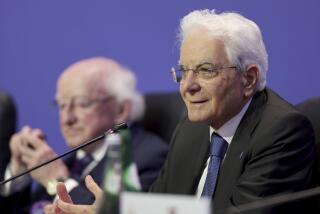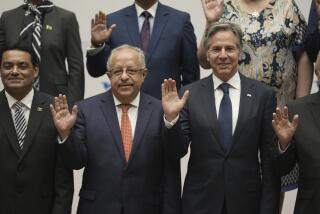Armenia, Azerbaijan work to ease tensions with help from Putin
The leaders of Azerbaijan and Armenia affirmed on Monday after talks with Russian President Vladimir Putin that they remain ready to pursue a negotiated solution to the conflict in the disputed territory of NagornoKarabakh.
Presidents Serzh Sargsyan of Armenia and Ilham Aliyev of Azerbaijan traveled to St. Petersburg for their second encounter since fighting broke out in Karabakh in early April after two decades of relative peace in the region.
Around 150 combatants died in several days of clashes.
Though the final declaration contained nothing new, Monday’s discussions appear to have reduced the likelihood of an escalation of hostilities.
In comments to the media prior to the meeting, Aliyev said that Baku would not tolerate a scenario of endless negotiations even as Armenian troops continue to occupy Karabakh along with contiguous areas of Azerbaijan proper.
Those remarks were in line with earlier statements by Aliyev and members of his government that Azerbaijan was ready for war and weary of waiting for the peace process overseen by the Minsk Group the U.S., France and Russia to produce results.
The joint proclamation that emerged from Monday’s session in St. Petersburg affirmed the commitment of all three presidents to maintaining regular contacts within the Minsk Group framework.
“The dialogue was very constructive,” Russian Foreign Minister Sergei Lavrov.
Aliyev and Sargsyan, who did not talk to reporters after the meeting, each ratified the April 5 ceasefire brokered by Moscow and pledged to allow an increase in the number of observers from the Organization for Security and Cooperation in Europe.
In an interview with EFE, the foreign minister of the ethnic Armenian selfproclaimed Republic of NagornoKarabakh said that representatives of the residents of the territory should be included in negotiations.
“To reach a definitive settlement, we must recover the tripartite format of the negotiations, as we decided in the 1994 Budapest summit,” Karen Mirzoyan said.
The conflict in NagornoKarabakh goes back to the collapse of the Soviet Union, when the region’s Armenian population sought unification with Armenia, leading to a 19911994 war that claimed more than 25,000 lives.
Armenian troops and their local allies now occupy the entire enclave and seven adjacent districts and have created a “security buffer” that represents just over a fifth of Azerbaijani territory.








